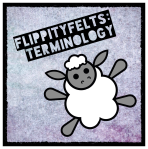
Felting terminology can seem a bit baffling, even to experienced felters. Well, let me remove your baffles and replace them with serenity, as I talk you through some of the terms you’ll come across in the world of needle felting.
- Armature – A ‘skeleton’, usually made from wire or pipe cleaners, that forms the base of a sculpture and is felted around. This technique can be useful in creating posable models or very thin parts such as legs or thin tails.
- Batts – Larger than rolags, batts are sheets of carded fibre (often with multiple thin layers) produced on a drum carder (aka ‘carded batts’).
- Blends – When different fibres/ colours are combined. This could be done to make an interesting colour combination or a wool that draws on different properties of the different fibres.
- Carded – Fibre that has been brushed so that the fibres go in multiple directions, as opposed to tops, which go in one direction. Typically comes in batts or rolags. Carded wool can be made either using large commercial felting machines, drum carders or hand carders.
- Cria – Baby alpacas. May be referred to on this site as ‘Chris’, due to my autocorrect’s wilful ignorance of animal husbandry terminology.
- Drum Carders – A wool-carding tool.
- Fibres – The word fibre is frequently used in place of wool; in part to differentiate from raw fleece or yarn, and in part to take into account the prevalence of non-sheep-wool materials such as alpaca, angora (rabbit), mohair or natural materials such as hemp or milk tops.
- Fleece – Fibre straight from the animal (typically sheep but may also refer to other animals.)
- Gauge – The gauge of a needle refers to the width of the needle. The higher the gauge the thinner the needle.
- Hand Carders – Squarish, flat brushes that look a little like dog brushes (and dog brushes can in fact be used as a cheaper alternative)
- Handle – The texture of a fibre: silky, harsh etc.
- Lanolin – Naturally occurring grease found in many breeds of sheep. Alpaca fleece does not contain lanolin.
- Locks – Unbrushed (although usually washed and dyed) curls in their natural form.
- Merino – A breed of sheep known for its very soft wool. There are ethical issues surrounding its use due to the practice of mulesing that is carried out in certain countries. However, it is more than possible to source this fibre ethically (ie from flocks where mulesing is not carried out), and some countries are phasing this practice out altogether.
- Micron – The thickness of a fibre. Lower numbers indicate thinner fibres.
- Mulesing – A technique used to prevent flystrike, this involves removing strips of wool-bearing skin from around the buttocks of the sheep to prevent flies, which would be attracted by faeces and urine.
- Nepps – Small, bobbly bits of waste wool often used to create texture.
- Noil – The short fibres left over from wool or silk production, often sold dyed in a similar form to a handkerchief. Less sturdy than felt but can be used for texture and decoration.
- Pre-felt – Partially-completed sheets of felt that have been matted together but not yet shrunk, and are therefore thicker than ‘normal’ felt.
- Raw Wool – Another term for fleece, although this can also indicate more clearly that the fleece is unwashed.
- Rolag – Hand-carded batts of fibre, typically small in size and often, but not always, taking the shape of a small roll of fibres.
- Rope – The way in which fibres such as tops and roving, are held together (ie taking the shape of a rope).
- Roving – Often incorrectly used when the term ‘tops’ should be used, roving is very similar to tops in that it typically comes in a rope and shares many of the same properties as tops. The primary differences are that roving is often thinner than the typical width of tops, and that the fibres are loosely carded. However, the similarities often mean that people confuse the two terms.
- Sliver – A much thinner form of roving. This isn’t usually used in needle felting and is a product most often used in spinning. Rhymes with ‘diver’.
- Staple – The length of the fibre r.e. how long it grows on the sheep.
- Tops – Brushed ropes of fibre used in all aspects of needle felting. In true tops the wool all flows in the same direction; commercial tops are much the same but with a tendency for the fibres to not completely flow in the same direction.